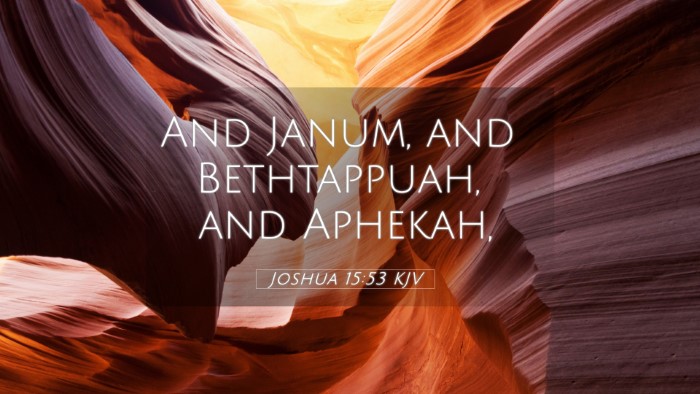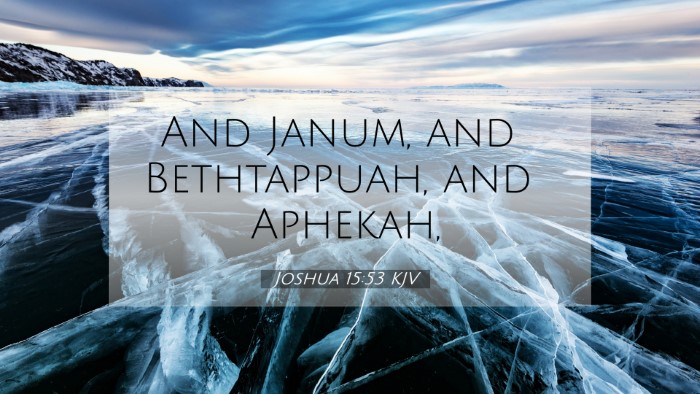Exploring Joshua 15:53: Insights from Public Domain Commentaries
Joshua 15:53 states: "And the dwellers in the valley were the Kenites, and the Kenizzites, and the Kadmonites." This verse mentions various peoples residing in the territory allotted to the tribe of Judah. To understand the depth of this verse, it’s essential to provide a cohesive interpretation drawn from respected public domain commentaries such as those by Matthew Henry, Albert Barnes, and Adam Clarke.
Meaning and Context
Matthew Henry highlights that the Kenites, Kenizzites, and Kadmonites are tribes that inhabited the land, playing a significant role in the context of Israel’s conquest. These names represent not just geographical groups, but also symbolize the diverse interactions that shaped Israel’s history. Shortly after the Israelite settlement, the presence of these tribes indicates the need for peaceful coexistence and potential conflicts, as these groups had established their presence long before the Israelites arrived.
Albert Barnes expands upon the historical significance of these tribes. He notes that the Kenites were likely descendants of Jethro, Moses’ father-in-law, suggesting a long-standing relationship between them and the Israelites. Moreover, the Kenizzites, referring to other pre-Israelite inhabitants, further contextualizes the struggle for land and identity in the Promised Land. Through this lens, Joshua 15:53 reflects the broader theme of God’s faithfulness in leading His people to their inheritance amidst challenges from other nations.
Adam Clarke adds that the specific mention of these tribes exemplifies God’s sovereignty in directing the course of history as He settled the Israelites. Their presence in the territory signifies both a challenge and an opportunity for the Israelites to embody God’s plan for them. Furthermore, he notes connections between these groups and other biblical accounts, creating a narrative thread that invites further exploration of related verses.
Cross-References and Thematic Connections
Joshua 15:53 can be linked to various passages throughout Scripture, enhancing our understanding of the verse through inter-biblical dialogue. Here are several relevant cross-references:
- Judges 1:16: Mentions the Kenites’ origin and their association with Judah.
- 1 Samuel 15:6: Refers to the Kenites as allies, highlighting their connection with the Israelites.
- Genesis 15:19-21: Discusses the inheritance of land from the Kenizzites, providing historical context.
- Exodus 3:1: Refers to Moses meeting Jethro, revealing the kinship of the Kenites with the Israelites.
- Numbers 24:21: Speaks of the Kenites’ destiny, linking their narrative to broader prophetic themes.
- Jeremiah 35: Examines the Rechabites, related to the Kenites, illustrating their commitment to family and heritage.
- Isaiah 21:16-17: Alludes to the fate of Kedar, drawing a parallel to the territorial dynamics present in Joshua 15:53.
- 1 Chronicles 2:55: Provides genealogical context to the Kenites, emphasizing their integration within Israelite history.
- Genesis 36:11: Connects the Kenizzites to the lineage of Esau, deepening the historical narrative.
- Deuteronomy 2:12: Mentions the seizing of lands by the Israelites from other peoples, contextualizing Joshua 15:53.
Interpreting Scriptural Connections
This verse invites comparative Bible verse analysis and thematic Bible verse connections. It serves as a bridge to understanding Israel’s complex relationships with neighboring tribes. This interplay is crucial for grasping the biblical narrative as it showcases:
- Thematic Identity: The ongoing struggle of God’s people to claim their promised land amid pre-existing communities.
- Historical Cross-Connections: The genealogical ties that bind various tribes, revealing the rich tapestry of Biblical history.
- Spiritual Applications: The relevance of coexistence and the moral fabric of integrating varied heritages within the community of believers.
Tools for Bible Cross-Referencing
For those wanting to delve deeper into the relation of Bible verses, tools for Bible cross-referencing are invaluable. A Bible concordance or cross-reference guide offers a structured approach to finding connections. Methods may include:
- Using Highlighters or Notes: Visual aids help in connecting theological themes and historical narratives across Scripture.
- Online Bible Study Tools: Digital databases and software that allow users to explore inter-Biblical dialogue easily.
- Community Study Groups: Engaging in discussions with others can unearth insights and foster a deeper understanding of Scripture.
- Comparative Study Methods: Drawing parallels between related verses, such as the themes in Deuteronomy and prophetic writings, enriches comprehension.
Conclusion
Joshua 15:53 serves as a pivotal verse that opens the door to understanding the convoluted relationships between Israel and surrounding nations. Through the lenses of Matthew Henry, Albert Barnes, and Adam Clarke, this verse reveals complexities in the territorial claims made by the Israelites and the significance of neighboring tribes. As we explore these connections, the practice of cross-referencing Bible verses enriches our understanding of Scripture and enhances our spiritual journey.


